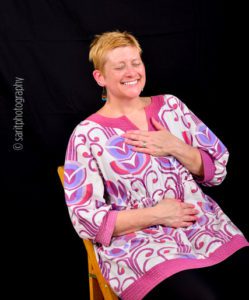Having physical challenges doesn’t mean traditional yoga poses are out of reach. Accessible/Adaptive Yoga Teachers like myself strive to make any pose possible. We see poses with new eyes and try to give students tools for a whole-body experience in their practice.
Adapting and customizing yoga poses are so important when it comes to body acceptance and diversity. It breaks down barriers to yoga and helps students feel supported and included.
I’ll never forget the first time I experienced an adaptive/accessible handstand in my practice. I was training to become an Opening Yoga Instructor (OYI) at Mind Body Solutions (MBS) in Minnesota. Since becoming a Registered Yoga Teacher (RYT 200), Yoga For All Teacher, and certified Accessible Yoga Teacher, I’ve attended many trainings that discuss traditional handstand. Yet, I never fully experienced the benefits of this pose firsthand because I have a spinal cord injury; therefore, practicing traditional handstand is ill-advised. Thankfully, Mind Body Solutions offers an adaptive approach that opens yoga to everyone.
To get into MBS’s adaptive handstand, place the short end of the mat facing the wall and lie down on the mat. You’ll want to make sure to leave enough room for arms to extend and touch the wall behind you. Use bolsters and towels for head, neck, and back support. Once props are in place, lift your gaze and arms above and behind the head while placing hands flat on the wall behind you- this mimics the position of hands on the floor in traditional handstand.
When I attempted the pose, I was exhilarated. Even though I was lying on my back on a mat, it felt like I was standing upright in traditional handstand. A zip of energy traveled up my legs, arms, and head. I felt alive and connected to my body in a new way. When I released my arms, tears welled up in my eyes. I felt the transformative power of yoga and a deep sense of calm in that moment. I’ll never forget it. It was life-changing.
Having physical challenges doesn’t mean traditional yoga poses are out of reach. Accessible/Adaptive Yoga Teachers like myself strive to make any pose possible. We see poses with new eyes and try to give students tools for a whole-body experience in their practice. We do this by slowing down movement and guiding students to explore and listen to their bodies. For me, the end goal is not how the pose looks, it’s more about the sensation that occurs in mind, body, and spirit.
So, the next time you approach a yoga pose, consider slowing down movement and feeling deeply into sensation. You might be surprised how one small adjustment can open yoga in new ways.
If we agree that yoga can be a vehicle for body acceptance and diversity, opening yoga by adapting and customizing poses empowers students on and off the mat.
NOTE: This post is part of a collaborative media series organized and curated by Omstars and the Yoga & Body Image Coalition intended as a deep dive into yoga & body
image.
Mary Higgs, MA, is a respected writer, online educator, speaker, mindfulness coach, and disability advocate. Developing a passion for mindfulness and becoming an Adaptive and Accessible Yoga Teacher transformed Mary’s life in unexpected ways. She loves sharing her message that transformation comes from within. She has published pieces in Yoga International, Devata Active, Yoga and Body Image Coalition, and Mind Body Solutions All-Humanity Newsletter. As a RYT, OYI, and certified Yoga for All and Accessible Yoga Teacher, Mary teaches people to explore and trust their inner wisdom, so they can live more authentically. Visit her online at YogiAble.com.











